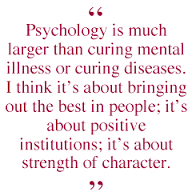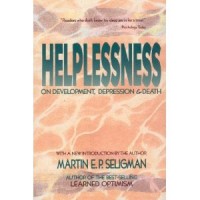Rating: 




Helplessness: On Depression, Development and Death (1992)
This book has consistently influenced me for many years. It highlights the importance of our need for control, real and perceived, over our environment. I first read it in connection with my work, but have found the theory of great personal benefit also. It may appear daunting if you are used to self-help books of a lighter tone, but deserves to be better known in the UK. I think this quote might explain its purpose. ” Learned helplessness refers to three things: First, an environment in which some important outcome is beyond control, second, the response of giving up, and third, the expectation that no voluntary action can control the outcome“. The book gives many of the famous studies of behavioral psychologists who worked with animals, with analysis of how they may shed light on human behaviour. Below, I quote from pages 174 to 183.
“Jane Goodall (Scarf M. Goodall and chimpanzees at Yale, New York Times Feb 18th 1973.) described the death of Flint, a young male chimpanzee, after his mother, Flo, died: Flo lay down on a rock, toward the side of a stream and simply expired. She was quite old. Flint stayed near her body, he grabbed one of her arms and tried to pull her up by the hand. The night of her death he slept close to the body, and by the following morning, he showed signs of extreme depression. After that, no ,matter where he might wander off to, he kept returning to his mother’s body. Finally he stopped coming back. But he did still remain in the area, comprising about 50 square yards, and he wouldn’t move any further away from the place Flo had died. In 10 days he had lost about a third of his body weight. He also developed a strange, glazed look. At last, Flint died too, he died very close to the spot where his mother had died. In fact, the day before he had returned to sit on the very rock where Flo had lain down (by then we had removed her body and buried her). The results of the post-mortem had been negative. They indicated that although he had a certain parasite load and one or two bugs, there was nothing sufficient in itself to cause death. So we had the death of his mother, an uncontrollable situation, a passive, depressed reaction, no obvious disease and unexpected death”.
“Institutional systems are all too often insensitive to their inhabitant’s need for  control over important events. The usual doctor-patient relationship is not designed to provide the patient with a sense of control. The doctor knows all, and usually tells little; the patient is expected to sit back and rely on professional help. While such extreme dependency may be helpful to certain patients in some circumstances, a greater degree of control would help others. Being hospitalized, then stripped of control over even simple things – such as when you wake up and what pyjamas you may wear, may promote efficiency, but it does not promote health”.
control over important events. The usual doctor-patient relationship is not designed to provide the patient with a sense of control. The doctor knows all, and usually tells little; the patient is expected to sit back and rely on professional help. While such extreme dependency may be helpful to certain patients in some circumstances, a greater degree of control would help others. Being hospitalized, then stripped of control over even simple things – such as when you wake up and what pyjamas you may wear, may promote efficiency, but it does not promote health”.
“H M Lefcourt witnessed a case of death due to a loss of will within a psychiatric hospital. A female patient who had remained in a mute state for nearly 10 years was shifted to a different floor of the building with her room-mates, while her unit was being decorated. The third floor of this psychiatric unit where the  patient in question had been living was known among the patients as the chronic, hopeless floor. In contrast, the first floor was more commonly occupied by patients who held privileges, including the freedom to come and go on the hospital grounds and the surrounding streets. In short it was an exit ward from which patients could anticipate discharge fairly rapidly. All patients who were temporarily moved from the third floor were given medical examinations prior to the move, and the patient was judged to be in excellent physical health, although still mute and withdrawn. Shortly after moving to the first floor, this chronic psychiatric patient surprised the ward staff by becoming socially responsive such that within a two-week period she ceased being mute and was actually becoming gregarious. In time, the work on the third floor unit was completed and the residents returned to it.Within a week after she had been returned to the ‘hopeless’ unit, this patient, who like the fictitious Snow White had been aroused from a living torpor, collapsed and died. The subsequent autopsy revealed no pathology of note, and it was suggested off-handedly at the time that the patient had died of despair (Psychological Bulletin,1966, 65, 206-220)”.
patient in question had been living was known among the patients as the chronic, hopeless floor. In contrast, the first floor was more commonly occupied by patients who held privileges, including the freedom to come and go on the hospital grounds and the surrounding streets. In short it was an exit ward from which patients could anticipate discharge fairly rapidly. All patients who were temporarily moved from the third floor were given medical examinations prior to the move, and the patient was judged to be in excellent physical health, although still mute and withdrawn. Shortly after moving to the first floor, this chronic psychiatric patient surprised the ward staff by becoming socially responsive such that within a two-week period she ceased being mute and was actually becoming gregarious. In time, the work on the third floor unit was completed and the residents returned to it.Within a week after she had been returned to the ‘hopeless’ unit, this patient, who like the fictitious Snow White had been aroused from a living torpor, collapsed and died. The subsequent autopsy revealed no pathology of note, and it was suggested off-handedly at the time that the patient had died of despair (Psychological Bulletin,1966, 65, 206-220)”.
“In 1967 a woman entered Baltimore City Hospital a few days before her 23rd birthday. She and two other girls, born to different mothers assisted by the same midwife, in Florida on a Friday 13th. The midwife (voodoo?) cursed all three babies, saying that one would die before her 16th birthday, the second, before her 21st birthday, and the third, before her 23rd birthday. The first, at 15, had died in a car crash, the second was accidentally shot to death on the evening of her 21st birthday. Now she, the third, waited in terror for her own death. The hospital somewhat skeptically admitted her for observation. The next morning, two days before her 23rd birthday, she was found dead in her hospital bed, physical cause unknown.”
This example alone demands an explanation. I accept this theory, of learned helplessness, to be the best possible, if not the only rational explanation. To quote Seligman: “Perhaps our modern self will come to see that its inordinate preoccupation with itself, while gratifying in the short run, is destructive of its well-being in the long run”. Do not be put off by the textbook style, it is more than worth the effort, it certainly will change your thinking on the power of optimism.
